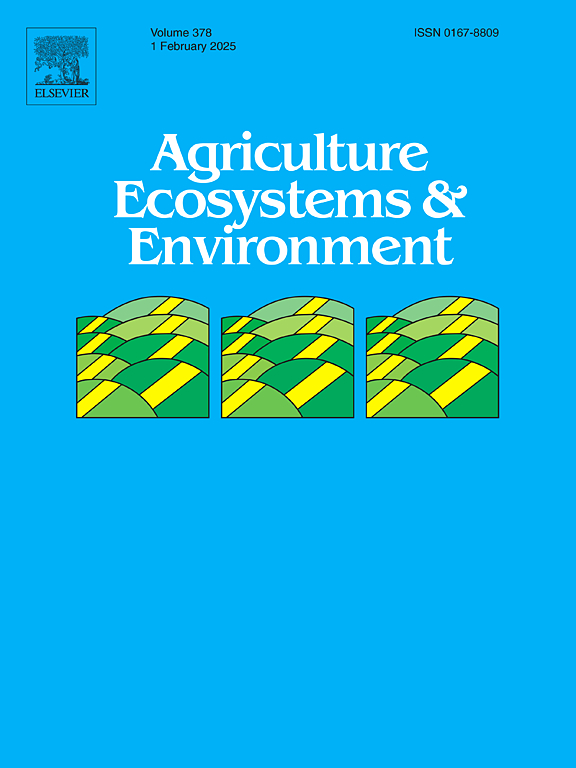Conversion of degraded forests to oil palm plantations in the Peruvian Amazonia: Shifts in soil and ecosystem-level greenhouse gas fluxes
IF 6
1区 农林科学
Q1 AGRICULTURE, MULTIDISCIPLINARY
引用次数: 0
Abstract
Oil palm (OP) expansion and associated forest clearance can significantly impact greenhouse gas (GHG) fluxes. We investigated carbon stocks and soil GHG (N2O, CO2, CH4) fluxes in a degraded forest and an adjacent 17-year-old OP plantation in Peruvian Amazonia. The plantation comprised three nitrogen (N) fertilizer treatments: 0 (OPN0), 84 (OPN1), 168 (OPN2) kg N ha−1 y−1. Carbon stocks were inventoried across all pools. GHG and environmental parameters were monitored monthly for 11 months and (bi)daily when fertilizing the OP, with measurements taken both near and far from trees/palms. Ecosystem-scale CO2equivalent losses from the conversion were computed by balancing carbon stock losses against N2O emission changes. N2O emissions (kg N ha−1 y−1) in the forest (6.7 ± 1.2) where litterfall N inputs were large (213 kg N ha−1 y−1) were 11, 5, and 3 times the emissions in OPN0 (0.6 ± 0.2), OPN1 (1.4 ± 0.2), and OPN2 (2.3 ± 0.3). In the plantation, 1 % of the N fertilizer applied was released as N2O. Across ecosystems, N inputs primarily controlled N2O emissions. Soil respiration (Mg C ha−1 y−1) was 1.4 times higher in the forest (9.1 ± 0.6) than in the plantation (7.3 ± 1, 5.5 ± 0.5, 6.5 ± 0.3 in OPN0, OPN1, OPN2). The forest was a soil CH4 (kg C ha−1 y−1) sink (-1.5 ± 0.3) while all OP treatments were sources (0.2 ± 0.3, 0.7 ± 0.5, 0.2 ± 0.4 in OPN0, OPN1, OPN2). Ecosystem carbon stock losses from forest-to-OP conversion were substantial (196.8 ± 44.0 Mg CO2 ha−1 15 y−1) and partially offset (14–20 %) by decreased N2O emissions. Complementary studies for this transition are needed to improve global GHG assessments.
秘鲁亚马逊地区退化森林向油棕种植园的转化:土壤和生态系统层面温室气体通量的变化
油棕(OP)扩张和相关的森林砍伐可以显著影响温室气体(GHG)通量。研究了秘鲁亚马逊地区一片退化森林及其附近一处有17年历史的OP人工林的碳储量和土壤GHG (N2O、CO2、CH4)通量。人工林包括3个氮肥处理:0 (OPN0)、84 (OPN1)、168 (OPN2) kg N ha−1 y−1。对所有池的碳储量进行了盘点。在11个月的时间里,每月监测一次温室气体和环境参数,在施用有机肥时每天监测一次,在树木/棕榈树附近和远处进行测量。通过平衡碳储量损失与N2O排放变化,计算了转化过程中生态系统尺度的co2当量损失。一氧化二氮的排放(y−1公斤N公顷−1)在森林里(6.7 ±1.2 )在litterfall N的输入是大(213 公斤 N公顷−1 y−1)11日,5和3倍排放OPN0(0.6 ±0.2 ),OPN1(1.4 ±0.2 ),和OPN2(2.3 ±0.3 )。在人工林中,1 %的氮肥以N2O的形式释放。在整个生态系统中,氮输入主要控制N2O排放。土壤呼吸(Mg C ha−1 y−1)在OPN0、OPN1、OPN2中为9.1 ± 0.6,是人工林(7.3 ± 1、5.5 ± 0.5、6.5 ± 0.3)的1.4倍。森林是土壤CH4 (kg C ha−1 y−1)汇(-1.5 ± 0.3),而所有OP处理都是土壤CH4源(OPN0、OPN1、OPN2中0.2 ± 0.3、0.7 ± 0.5、0.2 ± 0.4)。森林到温室气体转化造成的生态系统碳储量损失很大(196.8 ± 44.0 Mg CO2 ha−1 15 y−1),部分被减少的N2O排放抵消(14-20 %)。为改进全球温室气体评估,需要对这一转变进行补充性研究。
本文章由计算机程序翻译,如有差异,请以英文原文为准。
求助全文
约1分钟内获得全文
求助全文
来源期刊

Agriculture, Ecosystems & Environment
环境科学-环境科学
CiteScore
11.70
自引率
9.10%
发文量
392
审稿时长
26 days
期刊介绍:
Agriculture, Ecosystems and Environment publishes scientific articles dealing with the interface between agroecosystems and the natural environment, specifically how agriculture influences the environment and how changes in that environment impact agroecosystems. Preference is given to papers from experimental and observational research at the field, system or landscape level, from studies that enhance our understanding of processes using data-based biophysical modelling, and papers that bridge scientific disciplines and integrate knowledge. All papers should be placed in an international or wide comparative context.
 求助内容:
求助内容: 应助结果提醒方式:
应助结果提醒方式:


